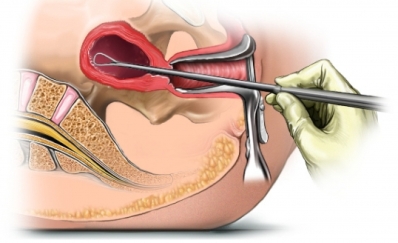Dilatation and curettage of the uterus curette – Dilation and curettage of the uterus
Description dilation and curettage of the uterus
Expansion is a procedure for opening and dilatation. Cervix – the entrance to the womb.
Curettage removing the inner lining of the uterus by scrapings. The mucous membrane of the uterus known as endometrium.
These procedures are usually performed together.

Reasons for dilatation and curettage of the uterus
- Dilation and curettage is usually held, to determine, What disease is abnormal bleeding. Some diseases, which can cause bleeding are:
- Miscarriage;
- Irregularities in menstrual bleeding;
- Endometrial Polyps;
- Abnormal endometrial thickening;
- Endometrial cancer;
- Sometimes dilation and curettage held, to stop the bleeding, but not for the diagnosis of bleeding. Sometimes this is done after a miscarriage or after childbirth, When the placenta did not come out completely;
- Dilation and curettage is not recommended, if you have:
- Infection of the uterus;
- Infection of the fallopian tubes.
Possible complications of dilatation and curettage of the uterus
Complications are rare, but no procedure does not guarantee the absence of risk. Before, how to perform a dilation and curettage of the uterus, you need to know about possible complications, which may include:
- Complications, associated with anesthesia;
- Injuries cervix;
- Scarring of the endometrium;
- Infection of the uterus or fallopian tubes;
- Uterine perforation (hole in the uterus);
- Bleeding;
- Damage to other organs in the abdominal cavity;
- In case of significant injury or bleeding, It may be necessary to open the abdomen and uterus to sew up the wound;
- Maybe, It requires removal of the uterus (hysterectomy).
Factors, that may increase the risk of complications include:
- Existing infection;
- Pre-existing diseases.
As a dilation and curettage of the uterus?
Preparation for the procedure
Consult your doctor about the drugs taken. A week before surgery you may be asked to stop taking some medicines:
- Aspirin or other anti-inflammatory drugs;
- Blood-thinning medicines, such as:
- Clopidogrel (Plaviks)
- Warfarin.
We need to organize a trip to the procedure and back home.
Anesthesia
Can be used local or general anesthesia. When using general anesthesia you sleep. Local anesthesia procedures numb the area, but you will stay awake.
Procedure dilatation and curettage of the uterus
There will be a gynecological examination, to identify the size and location of the uterus. The vagina and cervix will be treated with an antiseptic solution. Special expander is placed in the vagina. Tool called cervical dilator is placed into the cervical canal.
After, as the cervical canal is slightly open slightly, tools in shape scoop, called a curette, It is inserted into the uterus. Curette used, to clear the endometrium and remove tissue through the vagina. After sampling the endometrium, Devices will be removed from the cervix and vagina.
Immediately after treatment
Endometrial tissue is sent to a laboratory for examination.
How long will dilatation and curettage of the uterus?
About 10 minutes.
Dilation and curettage of the uterus – Does it cause pain?
General anesthesia will prevent pain during the procedure. When using a local anesthetic may feel some big muscle spasm and pain. Symptoms can last for days after the procedure. The-counter pain medicine – all, that typically must, to relieve minor discomfort.
Caring for the patient after dilatation and curettage of the uterus
Care in a hospital
After the procedure, you will be directed to the chamber to restore. After a while, you can leave the hospital. Ask someone to help take you home.
Home Care
When you return home, follow these steps:, to ensure the normal recovery:
- Be sure to follow your doctor's instructions;
- Ask the doctor, when you can go back to work. Besides, you can not get behind the wheel, until the doctor says, it's safe;
- There may be some nausea from the anesthesia;
- There may be light uterine cramping. The doctor may give pain medicine to relieve discomfort;
- For some time, there may be some vaginal bleeding or discharge;
- In most cases, you can resume normal activity within a few days;
- Do not insert anything into your vagina to doctor's permission. The cervix is open for a while, and it may increase the risk of infection in the uterus;
- The next menstrual cycle may be irregular. He may start earlier or later.
Usually, a few days later the doctor receives a report from the lab. The study doctor may prescribe medication or additional studies.
Contact your doctor after dilatation and curettage of the uterus
After returning home, you need to see a doctor, If the following symptoms:
- Signs of infection, including fever, chills, increased pain, or bad-smelling discharge from the vagina;
- Nausea and vomiting, that does not stop;
- Abdominal pain;
- Vaginal bleeding, filling more than one hour in the sanitary napkin;
- Cough, shortness of breath or chest pain.
